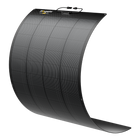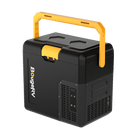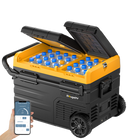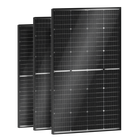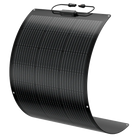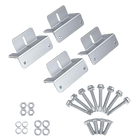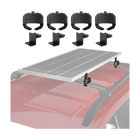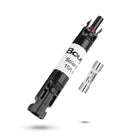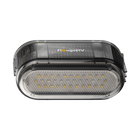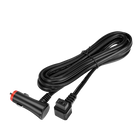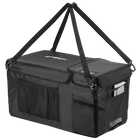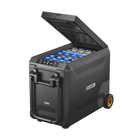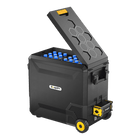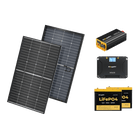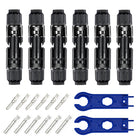What Size Charge Controller Do I Need?


Selecting the right size of solar charge controller is crucial for your solar system’s efficiency and battery protection.
But how do you know what size charge controller do you need?
In this blog post, we will explain what a solar charge controller is, how it works, and how to select the right-size charge controller for your solar system. We will also provide some examples of common systems and corresponding charge controller sizes, as well as some helpful tips and tools to make the process easier.
Let’s dig in!
Understanding Solar Charge Controller

A solar charge controller regulates the voltage and current from the solar panels to the battery bank, ensuring that your batteries are charged optimally without being overcharged or undercharged. It's essential for maintaining the longevity and performance of your solar power system. Typically, charge controllers come in 12, 24 and 48 volts. Amperage ratings can be between one and 60 amps and voltage ratings from six to 60 volts.
There are two main types of solar charge controllers: PWM (pulse width modulation) and MPPT (maximum power point tracking). PWM charge controllers are more simple and affordable, but they are less efficient and compatible with modern solar panels. MPPT charge controllers are more advanced and expensive, but they can extract up to 30% more power from the solar panels and adjust to varying weather conditions.
The main functions of a solar charge controller are:
-
Prevent overcharging.
-
Prevent over-discharging.
-
Prevent reverse current flow.
-
Provide multi-stage charging.
Easy Steps on Sizing Charge Controllers
The size of the charge controller mainly depends on two factors: the current of solar arrays and the system’s voltages. Here's a step-by-step guide with examples to help you select the perfect charge controller.
Step 1: Identify Your Solar Array Specifications
First, you need to determine the wattage, voltage, and current (measured in watts, volts, and amps, respectively) of each solar panel.
For example, if you have three 100W panels, each with a maximum power voltage (Vmp) of 20V and a maximum power current (Imp) of 5A, your total output would be 300W.
Step 2: Match the Voltage of Your Battery Bank
Ensure the charge controller matches the voltage of your battery bank. If you have a 12V battery bank, choose a charge controller rated for 12V systems.
Step 3: Calculate the Maximum Current Output
Calculate the Maximum Current Output in Parallel:
For parallel connections, where the voltage stays the same while the current accumulates, add up the current from each panel.
Using the example above, if all three solar panels are connected in parallel:
Maximum Current = Imp of one panel * Number of panels
Maximum Current = 5A * 3 = 15A
Calculate the Total Voltage and Current for Series Connections:
When wiring in solar panels in series, the current remains the same, but voltages add up. Therefore, if your solar panels are connected in series, you'd sum up the voltages instead.
Continuing with the example, if all three solar panels are wired in series:
Total Voltage = Vmp of one panel * Number of panels
Total Voltage = 20V * 3 = 60V
In this case, you'd need a charge controller that can handle at least 60V.
Step 4: Add a Safety Margin
Add a safety margin to account for increases in current due to intense sunlight conditions or reflections. A common practice is to add 25%:
Safety Margin Calculation = Max Current * 1.25
For parallel connection example:
Required Current Capacity = 15A * 1.25 = 18.75A
So, for three 100W solar panels wired in parallel, a charge controller rated for at least 19A would be suitable.
Step 5: Consider Future Expansion
If you plan to expand your solar system, choose a larger charge controller than what you currently need. This will save you money and hassle in the long run, as you won't have to replace your existing charge controller with a bigger one later on.
Choose Between PWM and MPPT Charge Controllers
MPPT charge controllers optimize the power output from solar panels, especially under varying light conditions. The MPPT charge controller is more suitable for larger or more complex systems than simpler PWM controllers.
The PWM charge controller will work effectively when the voltage of your solar array is close to your system's voltage. On the other hand, if the voltage from your solar panels is significantly higher than that of your battery bank, the MPPT charge controllers are the better choice as they can convert the excess voltage into usable power for charging.
PWM Charge Controller

The PWM solar charge controller works by rapidly switching the connection between the solar panel and the batteries on and off, thereby controlling the charging process through pulse width modulation (PWM). A PWM charge controller helps maintain the battery at its absorption voltage, which optimizes charging and extends the battery's lifespan. However, it cannot adjust voltages.
Pros:
-
Cheaper and simpler to use. PWM charge controllers are an excellent choice for those on a tight budget.
-
Best for smaller solar setups. These include applications such as vans, RVs, and tiny houses where efficiency is not as critical.
-
Best for warm, sunny weather. PWM charge controllers perform optimally under these conditions.
-
Generally longer lifespan due to having fewer components that could potentially break down.
-
Performs best when the battery is near a full state of charge. PWM technology is most effective in maintaining and finishing off the battery's charge.
Cons:
-
Less efficient: They’re less efficient when there's a discrepancy between panel voltage and battery voltage. Their efficiency also drops in cold climates and fluctuating weather conditions.
-
Not ideal for large systems. As they are not as versatile with high voltage inputs, PWM charge controllers may not be the best choice for larger solar systems requiring higher voltages.
-
Lower energy harvest. PWM controllers cannot convert excess voltage into additional current, leading to potential energy losses if the solar panel produces more voltage than what the battery can accept.
-
Less flexibility: The need to match the solar panel voltage to the battery bank limits the types of panels you can use with PWM controllers, reducing flexibility in system design.
MPPT Charge Controller

The MPPT charge controller extracts the highest possible power from your solar panels. It works by pinpointing the solar panel array's maximum power point (MPP) and adjusting the electrical operating point to maximize energy production.
Unlike traditional PWM controllers, MPPT charge controllers are intelligent devices that can adapt to changing light conditions and ensure that your batteries are charged with maximum efficiency.
One of the standout features of MPPT charge controllers is they can convert excess voltage into amperage. This feature is particularly beneficial when the solar panel voltage is higher than the battery voltage, as it allows for more energy to be stored and reduces power loss, even during less-than-ideal sunlight conditions.
Pros:
-
Highly efficient. MPPT charge controller performs exceptionally well in cold climates and when the sky is partially cloudy, maximizing energy harvest.
-
Ideal for higher voltage panels. For example, if your solar array's voltage is 36V and your system voltage is 12V, an MPPT charge controller will be more suitable. Conversely, if your solar array's voltage is 18V and your system voltage is 12V, a PWM charge controller will work fine.
-
Scalable. MPPT charge controllers operate effectively with large and expandable solar power systems, making them suitable for a diverse range of applications.
-
Reduced wiring costs. Due to their ability to handle higher voltage inputs, MPPT charge controllers can use thinner, less expensive wiring without compromising efficiency or performance.
Cons:
- Expensive and complex
PWM Charge Controller Sizing
PWM charge controllers don’t limit their current output; they pass through the current generated by the solar array. If the solar array can produce more current than what the charge controller is rated for, this could damage the charge controller. So the PWM charge controller should have an amperage rating that can handle or exceed the total current produced by your solar panels when connected in parallel.
For example, if your solar array can produce 15A, as per the above example, you would want at least a 19A PWM charge controller to include a safety margin. It's also essential that the input voltage from the solar panels does not exceed the maximum voltage limit of the PWM charge controller.
MPPT Charge Controller Sizing

Given that a 40A solar charge controller can handle 12V or 24V battery banks and accept up to 100 volts of input, let's consider a solar panel configuration.
If you have four 100W solar panels connected in series, each with an open-circuit voltage of 22.5V, then the total open-circuit voltage would be 90V (calculated as 22.5V*4). Since this total voltage is less than the 100V limit, the 40A MPPT charge controller is compatible with this solar panel system.
MPPT charge controllers are beneficial when there is a significant distance between the solar panels and the battery bank because they allow for using higher voltages with lower current, resulting in less power loss due to the resistance in long cables.
Examples of Common System Sizes and Their Charge Controller Sizes

1. What Size Charge Controller for a 200W Solar Panel?
If you have a 200W solar panel with a Voc of 22V, and your system voltage is 12V, your maximum charge current is 16.67A (200W ÷ 12V=16.67A ).
Adding a safety margin of 25%, your minimum required charge controller rating is 20.83A. A 20A or 30A charge controller will work fine for this 200W system.
2. What Size Charge Controller for a 300W Solar Panel?
If you have a 300W solar panel with a Voc of 22V, and your system voltage is 12V, your maximum charge current is 25A (300W ÷ 12V=25A).
Including a safety margin of 25%, your minimum required charge controller rating is 31.25A. Therefore, a 30A or 40A charge controller will work fine for this system.
3. What Size Charge Controller Do I Need for a 100ah Battery?
If you have a 100Ah battery with a nominal voltage of 12V, and your solar array wattage is 400W with a Voc of 22V, your maximum charge current is 33.33A (400W ÷ 12=33.33A).
Adding a safety margin of 25%, your minimum required charge controller rating is 41.66A. So, a 40A or 50A charge controller will work fine for this system.
4. How Many Watts Can a 30-Amp Charge Controller Handle?
A 30-amp charge controller can handle up to 360 watts of solar panel output for a 12-volt system and up to 720 watts for a 24-volt system. It’s crucial to match your solar panels' voltage and current output with the charge controller's capacity to prevent overloading and ensure a safe, efficient solar installation.
To calculate the wattage that a 30-amp charge controller can handle, you can use the formula: Watts = Volts x Amps
So, here's how you do the math:
For a 12-volt system:
- The maximum watts = 12 volts x 30 amps
- Maximum watts = 360 watts
For a 24-volt system:
- The maximum watts = 24 volts x 30 amps
- Maximum watts = 720 watts
5. How Many Watts Can a 50-Amp Charge Controller Handle?
If you have a 50A charge controller and your system voltage is 12V, the maximum wattage that your charge controller can handle is 600W.
6. How Many Watts Can a 60 Amp Charge Controller Handle 12V?
If you have a 60A charge controller and your system voltage is 12V, the maximum wattage that your charge controller can handle is 720W.
Other Factors to Consider When Sizing Your Charge Controller
When selecting the right size charge controller, there are additional factors to contemplate:
-
Environmental Conditions: Extreme temperatures can affect charge controller performance. Consider invest models, BougeRV’s 40A MPPT Solar Charge Controller, for example, includes temperature compensation features to handle fluctuating conditions.
-
Cable Sizes and Distances: The wire size between your solar panels, charge controller, and battery bank is crucial. Incorrect sizing can lead to voltage drop, reducing system efficiency.
-
Type of Battery: Different batteries (AGM, Lithium-ion, Lead-acid) have varied charging profiles. Ensure your controller matches the specific needs of your battery type.
-
System Load: If you're powering loads directly from the charge controller, consider this in your sizing to manage the extra current.
Helpful Charge Controller Sizing Calculator
To streamline the process, many online calculators can help calculate the charge controller size needed for your solar array. By inputting details such as total PV array wattage, battery bank voltage, and de-rating factors, these calculators offer an easy way to approximate the correct controller size.
BougeRV’s PWM and MPPT Charge Controller
Planning to set up or expand your solar system? BougeRV offers wide types of solar panels as well as solar charge controllers and solar components
In terms of the solar charge controller, we provide solar charge controllers suitable for system sizes of 12V~48V. Whether you are looking for more affordable and simpler PWM controllers or efficient MPPT controllers, BougeRV has options to match your requirements.
Interested in more of BougeRV’s solar charge controller? Explore now!
Conclusion

In conclusion, selecting the appropriate size charge controller is critical for the efficiency and longevity of your solar power system. By understanding your system's voltage, calculating the current from your solar panels, and factoring in potential expansion, you can ensure optimal performance and protection for your investment.
With the right-size solar charge controller, you'll be set to harness solar energy effectively while protecting your batteries and equipment!
FAQs
1. Can You Use More Than One Charge Controller?
Using multiple charge controls within a solar power system is particularly useful when dealing with large arrays. Or, it’s effective to use multiple solar charge controllers when solar panels are positioned in different orientations, which might have varying power conditions.
2. What Is the Upper Voltage Limit?
The upper voltage limit for a charge controller depends on its model and specifications. Typically, MPPT charge controllers have higher voltage limits than PWM controllers. You can check the manufacturer's datasheet to find the exact voltage limit for your specific model.
3. Do You Always Need a Solar Charge Controller?
A solar charge controller is essential in most solar power systems to regulate the voltage and current from the solar panels to the battery. It prevents overcharging and extends battery life. However, tiny systems with a solar panel output below 5W don’t need a controller.
4. What Size Charge Controller Do I Need for 1000 Watts
For a 1000-watt solar array at 12 volts, you would need an approximately 83-amp charge controller (1000W/12V = 83.33A). It’s wise to consider some extra capacity for efficiency losses, so a 90 or 100-amp controller would be advisable.
5. How Many Watts Can a 100-Amp Charge Controller Handle?
At 12 volts, a 100-amp charge controller can handle up to 1200 watts (12V x 100A = 1200W). For a 24-volt system, it can manage up to 2400 watts (24V x 100A = 2400W).
6. Should I Oversize My Charge Controller?
Oversizing your charge controller can be beneficial as it allows for future expansion of your solar panel system and ensures that the controller isn't constantly working at its maximum capacity, which can increase its lifespan and reliability.





